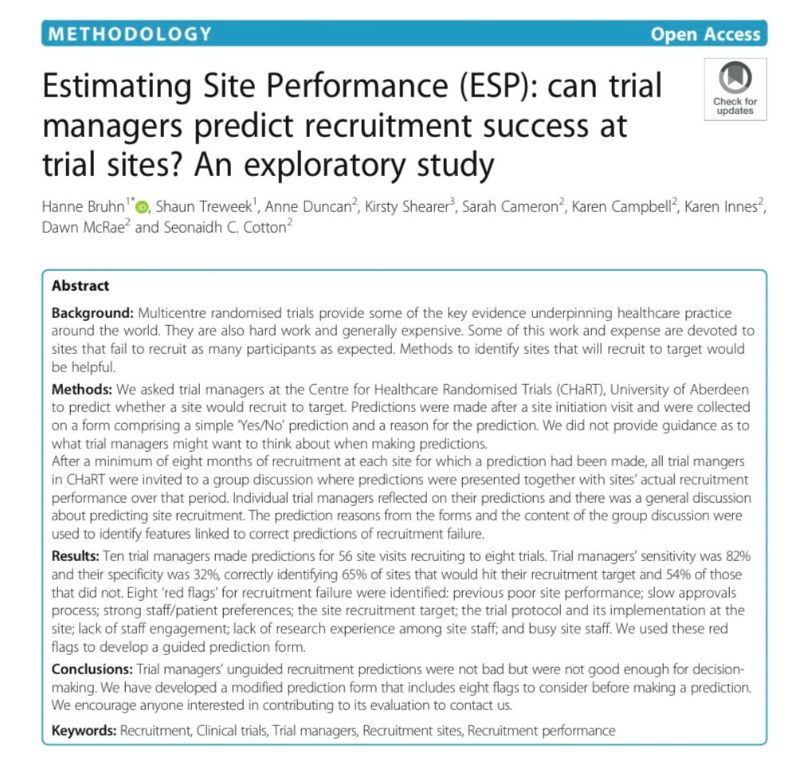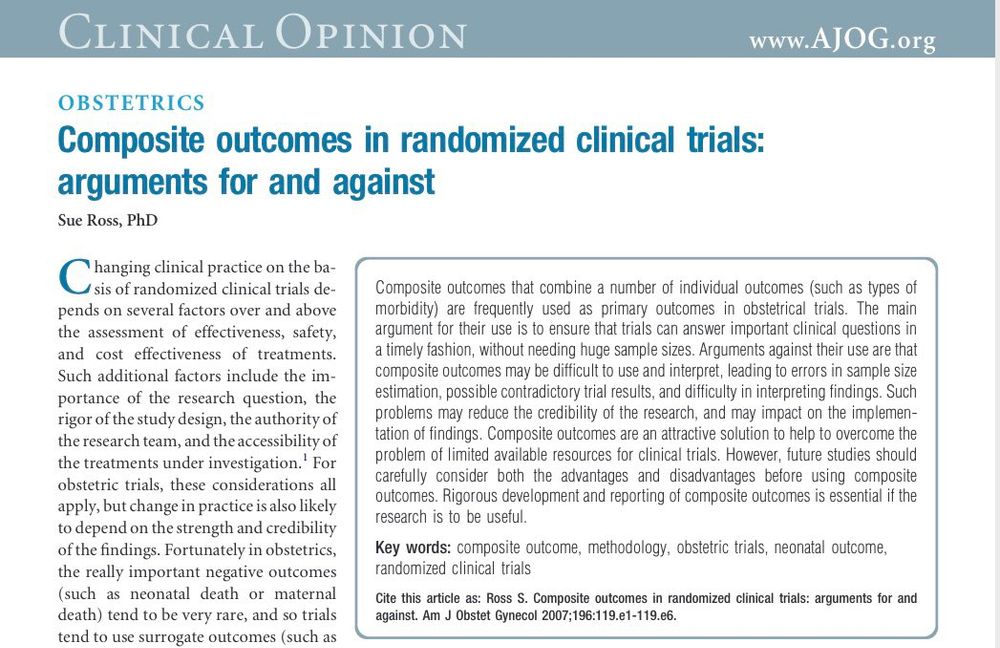
Marion Campbell
@marionkcampbell.bsky.social
Trialist; Methodologist; Statistician; Professor of Health Services Research; University of Aberdeen. Views my own. Hebridean.
https://www.abdn.ac.uk/people/m.k.campbell
https://www.abdn.ac.uk/people/m.k.campbell
The work provides accessible definitions of the core elements of an estimand which will help aid understanding and should ease the use of the estimand framework across the range of stakeholders 8/8

November 3, 2025 at 7:44 AM
The work provides accessible definitions of the core elements of an estimand which will help aid understanding and should ease the use of the estimand framework across the range of stakeholders 8/8
Kahan et al provide a useful introduction to the estimand approach and to the different terms/approaches used: 5/8
www.bmj.com/content/384/...
www.bmj.com/content/384/...

November 3, 2025 at 7:44 AM
Kahan et al provide a useful introduction to the estimand approach and to the different terms/approaches used: 5/8
www.bmj.com/content/384/...
www.bmj.com/content/384/...
It’s the UN #WorldStatisticsDay today! Perfect time to celebrate all the awesome statisticians who ensure robust data, design and analysis 😊

October 20, 2025 at 10:45 AM
It’s the UN #WorldStatisticsDay today! Perfect time to celebrate all the awesome statisticians who ensure robust data, design and analysis 😊
Bigirumurame et al also published a useful review of SMART trials and highlighted the need for accurate reporting 7/7
www.sciencedirect.com/science/arti...
www.sciencedirect.com/science/arti...

October 20, 2025 at 6:39 AM
Bigirumurame et al also published a useful review of SMART trials and highlighted the need for accurate reporting 7/7
www.sciencedirect.com/science/arti...
www.sciencedirect.com/science/arti...
In a SMART trial each individual can undergo multiple randomisations. All get initially randomised in stage 1, but non-responders can then get randomised in stage 2 to further treatment options etc 2/7

October 20, 2025 at 6:39 AM
In a SMART trial each individual can undergo multiple randomisations. All get initially randomised in stage 1, but non-responders can then get randomised in stage 2 to further treatment options etc 2/7
Lovely autumn colours on campus 🍂🍁 @uniofaberdeen.bsky.social



October 6, 2025 at 4:08 PM
Lovely autumn colours on campus 🍂🍁 @uniofaberdeen.bsky.social
The MRC complex intervention framework gives a useful summary of the range of people whose views should be considered. It also encourages adopting a diverse approach. 3/7
See www.bmj.com/content/374/...
See www.bmj.com/content/374/...

September 22, 2025 at 6:10 AM
The MRC complex intervention framework gives a useful summary of the range of people whose views should be considered. It also encourages adopting a diverse approach. 3/7
See www.bmj.com/content/374/...
See www.bmj.com/content/374/...
📣FUNDING ALERT: The NIHR/MRC Better Methods Better Research Programme has three new calls open:
- Researcher-Led
- Methodology for the incorporation of health and environmental impacts in health/social care
- Guidance development
Closing 2nd Dec
See: www.nihr.ac.uk/funding-oppo...
- Researcher-Led
- Methodology for the incorporation of health and environmental impacts in health/social care
- Guidance development
Closing 2nd Dec
See: www.nihr.ac.uk/funding-oppo...

September 15, 2025 at 9:50 AM
📣FUNDING ALERT: The NIHR/MRC Better Methods Better Research Programme has three new calls open:
- Researcher-Led
- Methodology for the incorporation of health and environmental impacts in health/social care
- Guidance development
Closing 2nd Dec
See: www.nihr.ac.uk/funding-oppo...
- Researcher-Led
- Methodology for the incorporation of health and environmental impacts in health/social care
- Guidance development
Closing 2nd Dec
See: www.nihr.ac.uk/funding-oppo...
A recent paper in the BMJ (by Ying et al) is a good read - with worked examples, tables and code to help calculate an appropriate pilot sample size. It also stresses the importance of aligning sample sizes with the objectives of the pilot study 6/6
www.bmj.com/content/bmj/...
www.bmj.com/content/bmj/...

September 8, 2025 at 6:42 AM
A recent paper in the BMJ (by Ying et al) is a good read - with worked examples, tables and code to help calculate an appropriate pilot sample size. It also stresses the importance of aligning sample sizes with the objectives of the pilot study 6/6
www.bmj.com/content/bmj/...
www.bmj.com/content/bmj/...
I agree - there needs to be much more done to improve the inclusivity of trials! There was a useful recent rapid response in the BMJ from @vickylshepherd.bsky.social outlining the importance of this, and some of the work being done in this space. www.bmj.com/content/390/...

August 19, 2025 at 1:08 PM
I agree - there needs to be much more done to improve the inclusivity of trials! There was a useful recent rapid response in the BMJ from @vickylshepherd.bsky.social outlining the importance of this, and some of the work being done in this space. www.bmj.com/content/390/...
For me using real world data - where we know bias is an issue - is akin to knowingly do a white wash with a pink (non-colourfast) sock inside. The resulting wash is completely coloured by the pink dye (this is like the bias in real world data) 6/9

August 18, 2025 at 6:35 AM
For me using real world data - where we know bias is an issue - is akin to knowingly do a white wash with a pink (non-colourfast) sock inside. The resulting wash is completely coloured by the pink dye (this is like the bias in real world data) 6/9
Whilst the scale and coverage of real world data is appealing, there remain problems with their use. A recent paper by Ali Abbasi, Rob Califf et al flagged some of the core issues – confounding, inadequate documentation, incomplete capture etc 3/9
www.nejm.org/doi/full/10....
www.nejm.org/doi/full/10....

August 18, 2025 at 6:35 AM
Whilst the scale and coverage of real world data is appealing, there remain problems with their use. A recent paper by Ali Abbasi, Rob Califf et al flagged some of the core issues – confounding, inadequate documentation, incomplete capture etc 3/9
www.nejm.org/doi/full/10....
www.nejm.org/doi/full/10....
Trial staff can also have early inklings that certain sites may not recruit well. Potential red flags have been identified incl. poor site engagement, strong site preferences etc. Ensuring sufficient high performing sites are included is essential 7/7
trialsjournal.biomedcentral.com/articles/10....
trialsjournal.biomedcentral.com/articles/10....

July 7, 2025 at 6:31 AM
Trial staff can also have early inklings that certain sites may not recruit well. Potential red flags have been identified incl. poor site engagement, strong site preferences etc. Ensuring sufficient high performing sites are included is essential 7/7
trialsjournal.biomedcentral.com/articles/10....
trialsjournal.biomedcentral.com/articles/10....
As Bogin notes in a paper discussing this … Lasagna’s Law is a dish best served early! You want to find out as early as possible what the true rate of recruitment to your trial will be. 5/7
www.sciencedirect.com/science/arti...
www.sciencedirect.com/science/arti...

July 7, 2025 at 6:31 AM
As Bogin notes in a paper discussing this … Lasagna’s Law is a dish best served early! You want to find out as early as possible what the true rate of recruitment to your trial will be. 5/7
www.sciencedirect.com/science/arti...
www.sciencedirect.com/science/arti...
“Lasagna’s Law” describes the often observed phenomenon that as soon as you start your clinical trial the number of potentially eligible patients you expect to see/recruit suddenly appears to plummet. 2/7

July 7, 2025 at 6:31 AM
“Lasagna’s Law” describes the often observed phenomenon that as soon as you start your clinical trial the number of potentially eligible patients you expect to see/recruit suddenly appears to plummet. 2/7
As such care needs to be taken before deciding whether to use a composite and, if so, which one. A neat summary of the pros & cons is outlined in this paper by Sue Ross 8/9
sciencedirect.com/science/arti...
sciencedirect.com/science/arti...

June 16, 2025 at 5:56 AM
As such care needs to be taken before deciding whether to use a composite and, if so, which one. A neat summary of the pros & cons is outlined in this paper by Sue Ross 8/9
sciencedirect.com/science/arti...
sciencedirect.com/science/arti...
Montori et al also stressed the need for all elements to be important to patients & suggest a set of questions to help with the interpretation of composite outcomes 4/9

June 16, 2025 at 5:56 AM
Montori et al also stressed the need for all elements to be important to patients & suggest a set of questions to help with the interpretation of composite outcomes 4/9
One of the primary reasons for using a composite outcome is trial efficiency - you can get more events quickly compared to the individual components thus increasing precision and efficiency in sample size calculations 2/9
jamanetwork.com/journals/jam...
jamanetwork.com/journals/jam...

June 16, 2025 at 5:56 AM
One of the primary reasons for using a composite outcome is trial efficiency - you can get more events quickly compared to the individual components thus increasing precision and efficiency in sample size calculations 2/9
jamanetwork.com/journals/jam...
jamanetwork.com/journals/jam...
#CCR25 … here we go! Three days of deep discussion of the top trials in critical care. If you are not in the room, do connect via livestream - see criticalcarereviews.com

June 11, 2025 at 7:47 AM
#CCR25 … here we go! Three days of deep discussion of the top trials in critical care. If you are not in the room, do connect via livestream - see criticalcarereviews.com
Guidance outlining key design points and specific reporting requirements was published earlier this year 7/7
www.bmj.com/content/388/...
www.bmj.com/content/388/...


June 2, 2025 at 6:38 AM
Guidance outlining key design points and specific reporting requirements was published earlier this year 7/7
www.bmj.com/content/388/...
www.bmj.com/content/388/...
They are particularly useful for evaluating treatments applied at a cluster level (say ward-level drug/treatment policies) which can be easily switched over and where there is no carry-over effects between treatment periods - see Hemming et al 3/7
www.bmj.com/content/371/...
www.bmj.com/content/371/...

June 2, 2025 at 6:38 AM
They are particularly useful for evaluating treatments applied at a cluster level (say ward-level drug/treatment policies) which can be easily switched over and where there is no carry-over effects between treatment periods - see Hemming et al 3/7
www.bmj.com/content/371/...
www.bmj.com/content/371/...
This week saw the publication of the accompanying editorial from Rachel Phillips and Victoria Cornelius providing a really useful overview of learning from the series 3/7
@vcornelius.bsky.social
@rachpips.bsky.social
trialsjournal.biomedcentral.com/articles/10....
@vcornelius.bsky.social
@rachpips.bsky.social
trialsjournal.biomedcentral.com/articles/10....

May 19, 2025 at 6:12 AM
This week saw the publication of the accompanying editorial from Rachel Phillips and Victoria Cornelius providing a really useful overview of learning from the series 3/7
@vcornelius.bsky.social
@rachpips.bsky.social
trialsjournal.biomedcentral.com/articles/10....
@vcornelius.bsky.social
@rachpips.bsky.social
trialsjournal.biomedcentral.com/articles/10....
Further information on the rationale for all the updated SPIRIT 2025 items can be found in the partner explanation and elaboration paper published in the BMJ 6/6
www.bmj.com/content/389/...
www.bmj.com/content/389/...

May 5, 2025 at 6:28 AM
Further information on the rationale for all the updated SPIRIT 2025 items can be found in the partner explanation and elaboration paper published in the BMJ 6/6
www.bmj.com/content/389/...
www.bmj.com/content/389/...
A number of the original SPIRIT items have been revised and some new ones added. The new checklist contains 34 items and there is a diagram to illustrate the schedule of enrolment, interventions and assessments (all agreed through a formal international consensus process) 4/6




May 5, 2025 at 6:28 AM
A number of the original SPIRIT items have been revised and some new ones added. The new checklist contains 34 items and there is a diagram to illustrate the schedule of enrolment, interventions and assessments (all agreed through a formal international consensus process) 4/6




